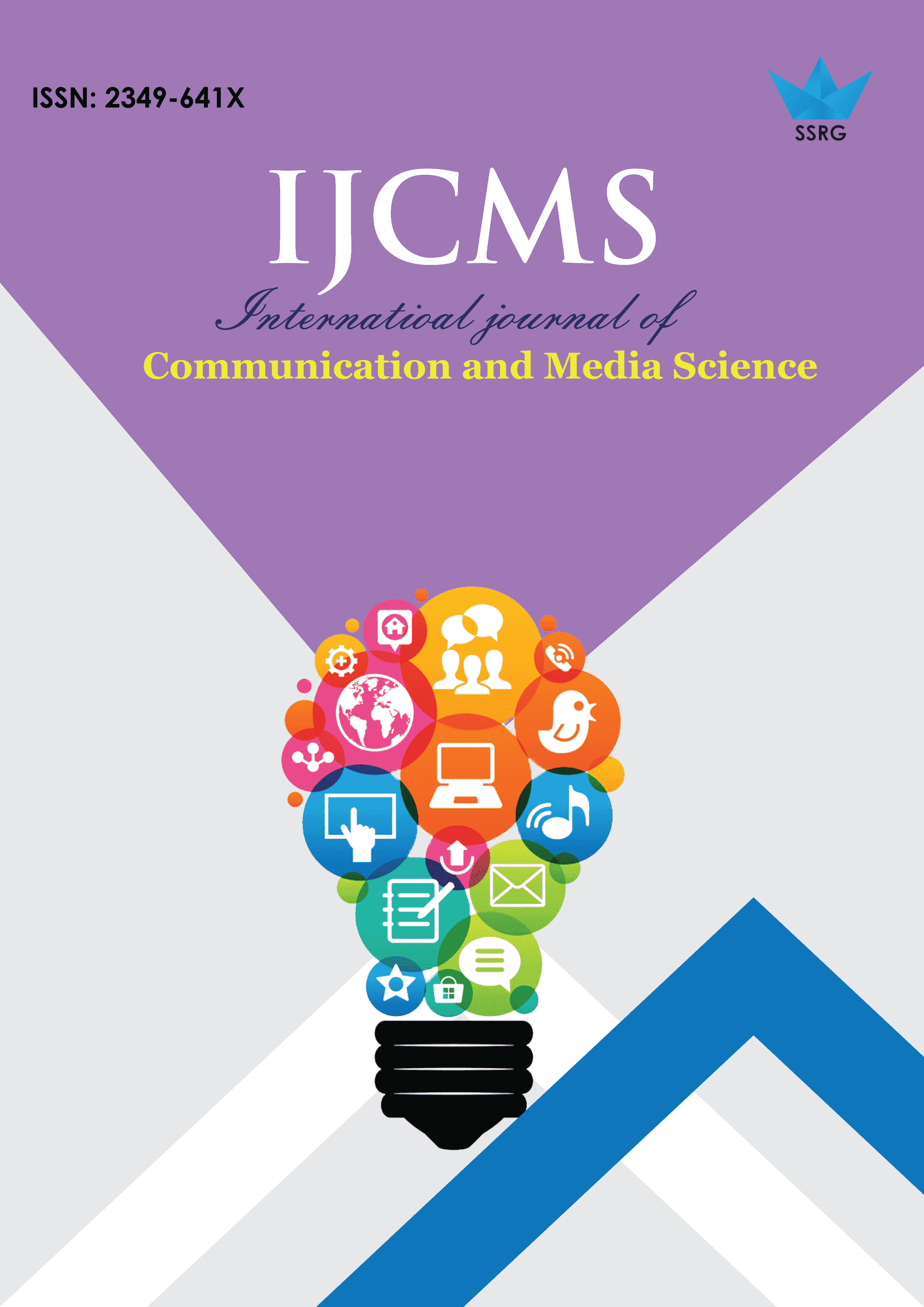A Review of Stakeholder Theory and its Application in Public Relations Practices

| International Journal of Communication and Media Science |
| © 2019 by SSRG - IJCMS Journal |
| Volume 6 Issue 3 |
| Year of Publication : 2019 |
| Authors : Eric Gbeneka Godam, Christie Omego, Chris Ochonogor |
How to Cite?
Eric Gbeneka Godam, Christie Omego, Chris Ochonogor, "A Review of Stakeholder Theory and its Application in Public Relations Practices," SSRG International Journal of Communication and Media Science, vol. 6, no. 3, pp. 15-22, 2019. Crossref, https://doi.org/10.14445/2349641X/IJCMS-V6I3P103
Abstract:
This paper reviews the stakeholder theory and its application in the study of the public relations practices of Electricity Distribution Companies in Nigeria. The stakeholder theory is a theory of organizational management and business ethics that accounts for various publics impacted by corporate units like customers, vendors, suppliers, employees, local communities, creditors, government agencies, environmentalists operating near the business entity, financial institutions and a host of other entities linked to the organisation or impacted by its activities. It instructs that there are many stakeholders in a company and their needs and appeal vary. It informs that the company’s success lies in satisfying all its stakeholders, and looking beyond those who might profit from the company’s stock. This analysis posits that the corporate environment as an ecosystem of interconnected assemblage, and they all need to be considered and contented to keep the organisation healthy and successful in the long run.
Keywords:
Public Relations, Stakeholder Theory, Publics, Power Distribution Companies, Nigeria
References:
[1] Adekunle, T. (2017).Public relations practices. Lagos: Talkback Publishers Limited.
[2] Ajala V.O. (2001). Public relations: In search of professional excellence. (3rded) Ibadan: May-Best Publications Limited.
[3] Ambler,T.(1992). Need to Know Marketing. CenturyBusiness: London.
[4] Amodu, L.A. (2012) Community relations and conflict resolution in the Niger Delta: A study of three major oil companies: A PhD thesis submitted to the department of mass communication, Covenant University, Otta, Ogun State, Nigeria.
[5] Awosope, C.A. (2014) Nigeria Electricity Industry: Issues, Challenges & Solutions. Otta: Covenant University Press, OttaOgun State, Nigeria
[6] Bernstein, D. (1991) Company Image & Reality. 2nd Edition, Cassell.
[7] Black, S. (1990). Introduction to public relations. London: West African Books Publishers Ltd.
[8] Cutlip, S.M., Center, A.H. & Broom, G.N. (2000).Effective Public Relations, (8th ed.) Upper Saddle River, New Jersey:Prentice-Hall International.
[9] Daugherty, E. L. (1992) Public Relations & Social Responsibility. In R. L. Heath (ed.) Handbook of Public Relations.Sage
[10] Fang, X.G. (2004). The Course of Public Relation (7thed.) Zhejiang: Zhejiang University Press.
[11] Freeman, E.R; Reed, D.L. (1983) Stockholders and Stakeholders: A New Perspective on Corporate Governance, California Management Review, Vol. XXV, No. 3,
[12] Furneaux, B. (2006). Stakeholder theory. Retrieved from http://www.istheory.yorku.ca/stakeholdertheory.htm
[13] Gregory, A. (2000). Planning and Managing Public Relations Campaigns (2nd .ed). London: Kogan Page Limited.
[14] Grunig, J. & Hunt, T. (1984).Managing Public Relations. New York: Rinchart and Winston Inc.
[15] Hartman, L. P. (2005). Perspectives in business ethics (3rcted). New York: McGraw-Hill Companies, Inc.
[16] Hasan, S. (2013).Mass Communication: Principles and Concepts. New Delhi: CBS Publishers and Distributors.
[17] Keller, K. L. (1998) Building, Measuring & Managing Brand Equity. New Jersey, Pearson Education Inc.
[18] Lu, C.R., & Lu, C.S. (2004).Modern Brand Strategy Operation. Shanghai: Huadong Science and Industry University Press.
[19] Mackiewicz, A. (1993) Guide to building a global image. Maidenhead: McGraw Hill.
[20] Marken, G. A. (1990). Corporate image - We all have one, but few work to protect and project it.
[21] Public Relations Quarterly (Spring), 21-23.
[22] McQuail, D. (2005). McQuail‟s Mass Communication theory (5th .ed). Los Angeles: Sage
[23] Murphy, K. J. (1990) Brand Strategy. Cambridge, England: Fitzwilliam International Group.
[24] Ohiagu, O. P. (2015). Fundamentals of Advertising and Public Relations. (2nd .ed) Port Harcourt: Accuracy Prints.
[25] Olins, W. (1989) Corporate Identity: Making Business Strategy Visible Through Design, London: Thames and Hudson.
[26] Stevens, K. K; Malone, P. C; & Bailey, C. M. (2005) Communicating with stakeholders during a crisis. Evaluating message strategy.Journal of Business Communication, 42 (4),390-419.
[27] Wilcox, D.L; Cameron, G.T; Ault, P.H; Agee, W.K; (2003) Public Relations, Strategies & Tactics, 7th edition, Allyn and Bacon
[28] Wragg, D.W. (1992). The Public Relations Handbook. Oxford: Blackwell Business
[29] Wu, M. Y. (2004). Public Relations in Taiwan: A 2005 Version. Public Relations Quarterly, 49(4), 19-21. Retrieved
from http://search.ebscohost.com.libproxy.aalto.fi/login.aspx?direct=true&db=ufh&AN=17249362&site=ehost-live
[30] Zeng, L. Z. (2005) New Edited Public Relations. Shanghai: Shanghai University of Finance & Economics Press.

 10.14445/2349641X/IJCMS-V6I3P103
10.14445/2349641X/IJCMS-V6I3P103